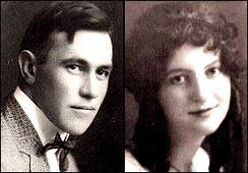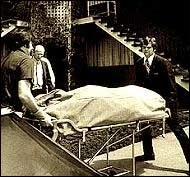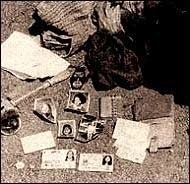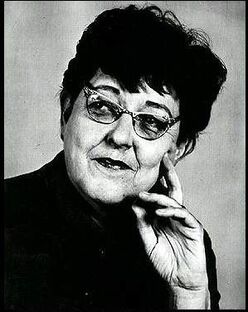| “ | When I see a pretty girl walking down the street, I think two things: one part of me wants to take her home, be real nice and treat her right; the other part wonders what her head would look like on a stick. | ” |
— Kemper
| ||
Edmund Emil "Ed" Kemper III, a.k.a. "The Co-Ed Killer" or "The Co-Ed Butcher", is an American rapist and necrophilic, ephebophilic, and cannibalistic serial/spree killer active in the early 1970s. His murders coincided with those of another California serial killer, Herbert Mullin.
Background[]
Kemper was born on December 18, 1948, in Burbank, California. His parents were Edmund Jr. and Clarnell Kemper (née Strandberg). He also had one older and one younger sister and was very close to his father. Because of this, he was troubled when they divorced in 1957 and his mother took Kemper and his sisters and moved to Helena, Montana. Though very bright (he was later found to have an IQ of 145 during adulthood), he displayed sociopathic traits at an early age; he was a pyromaniac and often used his sisters' dolls to enact murders and bizarre sexual rituals. He particularly enjoyed pulling their heads off. He took great delight in torturing and killing cats; one of them he stabbed to death. Another he reportedly buried alive, dug up again, decapitated it and put its head on a pole. He fantasized about being executed by electric chair and would often enact it as a game with his sisters. His emotionally abusive mother would often lock him in the basement because she was afraid that he would rape the youngest, the basement often being filled with rats. At the age of 13, he ran away and made it all the way to his father in California, only to discover that he had remarried and made his stepson the object of his affection. Kemper, heartbroken, was sent back to his mother.

Edmund Sr. and Maude Kemper, his grandparents (in their youth).
At the age of 14, Kemper was sent to live with his paternal grandparents, Edmund Sr. and Maude Kemper, at their ranch in North Fork, California. Even though he already was an imposing 6 foot 4 inches (1,93 m) tall, he was easily bullied by classmates. He also didn't get along with his grandmother. On the afternoon of August 27, 1964, he shot and killed first her, then Edmund Sr., with a rifle that had been given to him for Christmas the previous year. Sources vary on exactly how it happened; some claim it was a spur of the moment after Kemper and she had an argument. Others claim that she was working on her next children's book when she was shot and that Kemper did it just to find out how it felt. He then killed his grandfather when he came home from grocery shopping to spare him the sight of his dead wife and made two phone calls; first to his mother to tell her what he had done and then to the local police to do the same. He then sat down on the porch and waited for their arrival. After being arrested, he was diagnosed with paranoid schizophrenia and placed in mental care at the Atascadero State Hospital for the Criminally Insane. He surprisingly got along well with his psychiatrist and was even made his assistant. On December 18, 1969, on his 21st birthday, Kemper was released against the wishes of several psychologists and placed in the care of his mother in Santa Cruz.
Serial Killings, Capture, and Incarceration[]
After being released, Kemper, still living with his mother, took a number of menial jobs before eventually getting a job at the State of California's Department of Public Works as a laborer. He was then 6 foot 9 (2,06 m) and weighed 300 pounds (136 kg). He befriended several local police officers and even planned to become one himself, a dream that ended when he learned that he was above regulation height. Though he wasn't good with money, he eventually saved up enough to move away from his mother and get an apartment with a roommate. After getting a $15,000 settlement through a motorbike accident, he bought a yellow Ford Galaxy and began cruising the Pacific coast area in search of female hitchhikers, all the while gathering kill supplies such as a knife, plastic bags and handcuffs. He eventually had to leave his apartment and move back in with his mother, who had been divorced a total of three times by that point. On May 7, 1972, he committed his first two murders as a serial killer. Over the following nine months, he killed four more women, coinciding with murders committed by fellow Californian serial killer Herbert Mullin. Many of his murders were committed after an argument with his mother. On April 19, 1973, he bludgeoned his mother to death in her sleep and spent hours mutilating her body, severing her head, using it for oral sex, tossing darts at it and throwing her vocal cords into the garbage disposer. When the murder didn't satisfy his homicidal needs, he invited over Sally Hallett, a friend of his mother, and killed her as well when she arrived.

Victim's body removed from Kemper's home.
Kemper then took his car and drove away, all the while listening to the radio for reports about his murders. After four days on the road without hearing any such broadcasts, he stopped at a phone booth in Pueblo, Colorado, called his friends at the Santa Cruz PD and confessed to his eight murders. At first, they thought it was a poor joke, but, after a few phone calls, learned that he was telling the truth. He then sat down in the car and waited for them to come and arrest him. After unsuccessfully pleading insanity, he requested to be sentenced to death and executed by electrical chair, like he had fantasized about, but due to the state having temporarily suspended capital punishment, he was denied his childhood dream and sentenced to life in prison. While in prison, he was one of the first 36 convicted killers to be interviewed by the then recently founded Behavioral Science Unit. He was interviewed three times by Robert Ressler. During the third time, the guards didn't respond when he called for them and he found himself locked in the small room alone with Kemper, who started making death threats and taunting him. When the guard finally came, he claimed to have been kidding. John Douglas, who also interviewed him, later admitted to liking Kemper, who was friendly, open, and sensitive when they spoke. In prison, Kemper has participated in audiobook programs to narrate taped readings of classic novels for curricula in institutes for blind students. Kemper also crossed paths with serial killer Herbert Mullin, who he conditioned to not sing to avoid annoying him and the other inmates, using peanuts and splashing water. Kemper is still (March 2021) serving his sentence at the California Medical Facility in Vacaville.
Modus Operandi[]

Trophies taken by Kemper from his victims.
"If I killed them, you know, they couldn't reject me as a man. It was more or less making a doll out of a human being... and carrying out my fantasies with a doll, a living human doll."
Kemper targeted women, most of whom were co-eds aged in their teens to mid-twenties, most of whom attended the same college his mother worked at. All victims during his serial killer period, with the exception of his mother and Sally Hallett, were hitchhikers who were given rides by him when he cruised around. After taking them somewhere secluded, chatting them up on the way, he would kill them in various ways, including shooting, stabbing, and strangling, and then take their remains to his room, where he would perform bizarre experiments on, eviscerate, and engage in sexual activities with their bodies. He would also decapitate his victims' heads and sexually penetrate them orally. One of the psychiatrists who interviewed him using a truth serum, Dr. Joel Fort, also believed that Kemper had cooked and eaten parts of his victims. He took Polaroid photos of their mutilated corpses as souvenirs. After he was done with the bodies, he would dispose of them, often by throwing them into a ravine or a gorge. The heads of some victims were buried in his mother's garden, with Kemper claiming he placed them there because his mother "always wanted people to look up to her". When he killed his grandparents, he shot them both with a .22 rifle.
Known Victims[]

Clarnell Strandberg, Kemper's mother.
- August 27, 1964: Edmund Sr. and Maude Kemper (his grandparents; both shot with a .22 rifle):
- Edmund Emil Kemper, Sr., 72 (shot in the back of the head)
- Maude Matilda Kemper, 66 (fatally shot once in the head and twice in the back post-mortem)
- 1972:
- May 7: Mary Ann Pesce and Anita Luchessa (both were manually strangled and fatally stabbed, then dismembered and decapitated post-mortem):
- Mary Ann Pesce, 18 (also attempted to strangle with terrycloth and non-fatally slashed her throat)
- Anita Mary Luchessa, 18
- September 14: Aiko Koo, 15 (attempted to suffocate, then raped and fatally strangled with her scarf; engaged in necrophilia with her corpse, dissected, and removed her head and hands post-mortem)
- May 7: Mary Ann Pesce and Anita Luchessa (both were manually strangled and fatally stabbed, then dismembered and decapitated post-mortem):
- 1973:
- January 7: Cynthia Ann "Cindy" Schall, 19 (shot in the head with a .22 pistol; engaged in necrophilia with her corpse, dissected, and dismembered post-mortem)
- February 5: Rosalind Thorpe and Allison Liu (both shot with a .22 pistol; engaged in necrophilia with their corpses and dismembered post-mortem):
- Rosalind Heather Thorpe, 24
- Allison Helen Liu, 23
- April 19:
- Clarnell Elizabeth Strandberg, 52 (his mother; bludgeoned with a claw hammer; mutilated and decapitated post-mortem, removed her vocal cords, and engaged in necrophilia with her corpse)
- Sara Taylor "Sally" Hallett, 59 (manually strangled, then fatally strangled with Aiko's scarf and decapitated post-mortem)
Notes[]
- Kemper's killings were part of the reason why Santa Cruz, California, earned the apt nickname "Murder Capital of the World". The other reasons were:
- The murders committed by serial killer Herbert Mullin and mass murderer John Linley Frazier happened around the same time.
- The Zodiac Killer was also active in the same state a few years earlier.
- Another cluster of murders suspected of being a serial case known as the "Astrological murders" were also committed in California around that time. Like Kemper, that offender also targeted women and disposed of their remains in ravines.
- The Manson Family, led by Charles Manson, and the Hillside Stranglers, Angelo Buono and Kenneth Bianchi, also committed several murders in California in the 70s.
- Additionally, Richard Ramirez, The Night Stalker, and an unidentified serial killer and rapist known as the Original Night Stalker were active in the state in both the 70s and the 80s, as was Lonnie David Franklin, who returned in the 2000s.
- Harvey Glatman, Richard Chase, Juan Corona, and Leonard Lake and Charles Ng were also active in California, as were William Bonin, Patrick Kearney, and Randy Kraft, the three of whom were believed to be a single serial killer known as The Freeway Killer.
On Criminal Minds[]
- Season One
- "Charm and Harm" - Kemper was mentioned as an example of killers who save their most meaningful murders for last, referring to how he killed his mother.
- Season Two
- "The Last Word" - While not directly mentioned or referenced in this episode, Kemper appears to have been an inspiration for The Mill Creek Killer - Both are necrophilic serial killers who targeted women, killed them via manual means (The Mill Creek Killer beat his victims to death, while Kemper killed by various means), engaged in necrophilia with them, were given nicknames by the media for their murders, and were active at the same time and place as another independant serial killer.
- Season Three
- "Doubt" - While not directly mentioned or referenced in this episode, Kemper appears to have been an inspiration for the episode's unsub, Nathan Tubbs - Both were spree killers (Kemper later) with almost identical victimologies (young female college students, though Kemper also killed others), picked up victims with their cars by offering them rides, stabbed them to death (though this was only one of Kemper's methods), performed ritualistic acts on their bodies after death (Tubbs stabbed his post-mortem and folded their arms across their chests, while Kemper eviscerated, experimented with, and even engaged in necrophilia with his), and kept souvenirs of some kind (Tubbs kept newspaper articles of his murders, while Kemper kept Polaroid photographs of his victims and their body parts).
- "Lucky" - While not directly mentioned or referenced in this episode, Kemper appears to have been an inspiration for the episode's unsub, Floyd Feylinn Ferell - Both are cannibalistic serial killers who had a younger sister, were institutionalized as minors for committing a violent crime against a family member (Kemper murdered his grandparents, while Ferell tried to eat his sister), read frequently while in their facilities, and were released after reaching adulthood (to the objections of their doctors). Both targeted women, brought them to a secondary location to be killed before bringing them to their homes to be dismembered post-mortem, kept at least some of their remains and cooked their flesh to make cannibalistic meals (particularly their legs), and at one point they were pulled over by a cop with a victim's remains in their car and were let off without issue. Both taunted FBI profilers while being interviewed, they both pleaded insanity and were ultimately found guilty (though Ferell was initially deemed insane), and both interacted with another killer who was initially mistaken for them (Kemper performed "behavior modification treatment" on Herbert Mullin, while Ferell convinced Marcus Manning to emulate his murders). Their appearances are also similar. Ferell also appeared in Season Thirteen.
- "Penelope" - Kemper was mentioned alongside Ted Bundy and Robert Anderson as examples of killers who appeared to gain sadistic satisfaction out of gaining the trust of their victims and out of lulling them into a false sense of security.
- "Limelight" - While not directly mentioned or referenced in this episode, Kemper appears to have been an inspiration for the episode's unsub, Jeremy Andrus - Both are rapists and serial killers who had sexually sadistic and misogynistic tendencies starting in childhood, were profiled as having been in broken homes and accumulating criminal records, worked in blue-collar jobs, targeted Caucasian female victims, lured them with a ruse before abducting them in their cars, killed their victims by asphyxiation (though Kemper used other means), left their victims' bodies to be found in outdoor areas, tried to get public attention once they weren't sexually satisfied from their murders (which included calling the police), attempted to kill two victims in one day at the ends of their sprees (though only Kemper succeeded), specifically their targets of fixation (Kemper's mother and the primary agent on Andrus' case, accordingly) and a friend of each targeted victim, surrendered to arrest once they were apprehended, and gave full confessions in interrogation.
- "Damaged" - While not directly mentioned or referenced in this episode, Kemper appears to have been an inspiration for Chester Hardwick - Both were serial killers who targeted women, seemingly killed them through similar means (though Hardwick's M.O. is never fully elaborated on), had similar sentences (Hardwick was sentenced to death and presumably executed off-screen, while Kemper wished to be sentenced to death by electric chair, but wasn't), and were both interviewed by FBI personnel. Their interviews took a turn when the guards failed to show up, resulting in both killers taunting and threatening their interviewers (Kemper repeatedly taunted and threatened to kill Robert Ressler, while Hardwick intended to kill Hotch and Reid), but never actually harmed them. The interviewers distracted the killers by talking to them and stalling them until the guards could arrive. Hardwick's physical appearance even seems to mimic Kemper's.
- Season Four
- "Zoe's Reprise" - While not directly mentioned or referenced in this episode, Kemper appears to have been an inspiration for the episode's unsub, Eric Ryan Olson - Both are serial killers who committed crimes before their later murders, appeared to mainly target one gender (Kemper mainly targeted young women, though did kill elderly ones as well as his grandfather, Olson appeared to have mainly targeted men, though also killed women), and had a varying M.O. Also Kemper's quote: "When I see a pretty girl walking down the street, I think two things: one part of me wants to take her home, be real nice and treat her right; the other part wonders what her head would look like on a stick." is somewhat similar to the one Olson gave to the BAU.
- Season Six
- "The Stranger" - In the episode, Kemper was compared by Reid to the episode's unsub, Greg Phinney and appears to have been based on him - Both were serial/spree killers who had close relationships with their fathers, were enraged when they were separated from them after they were institutionalized prior to their killings (in Kemper's case, his father remarried, moved to another state and got a stepson, in Phinney's case, his father remarried and died), killed animals as minors, were active in California, targeted female college students as surrogates for the women who were the true targets of their rage - their mothers (though it was a stepmother in Phinney's case), chatted them up before killing them, stabbed them to death (though Kemper's M.O. was various), performed ritualistic actions on them post-mortem, had some sexual element in their crimes (Kemper had sex with his victims' remains, while Phinney sexually violated his last victim), and were both given the nickname "The Co-Ed Killer".
- Season Seven
- Season Eight
- "Carbon Copy" - While not directly mentioned in this episode, Kemper's surname was used for the minor serial killer Jack Lee Kemper, who was only mentioned in passing.
- Season Nine
- "The Edge of Winter" - While not directly mentioned or referenced in this episode, Kemper appears to have been an inspiration for the episode's unsub, Joe Bachner - Both are serial killers who were abused by a maternal family member (Kemper's mother and Bachner's aunt, respectively), with such abuse including being locked in enclosed spaces with other animals (Bachner's aunt locked him in a shed and swarmed with with bees, Kemper's mother locked him in a basement filled with rats), intended to kill their extended relatives and abusive maternal figures (though Bachner's aunt died from a heart attack before he could try, while Kemper successfully killed both his grandparents, then killed his mother years later), targeted Caucasian women in their 20s (though Bachner also targeted men and one black-American woman, while Kemper targeted teenagers and middle-aged women, including his mother), lured their victims into their cars with ruses, tortured and killed their victims by stabbing (though Kemper used other means), raped at least one of their female victims, and disposed of their victims in open areas.
- Season Eleven
- "The Night Watch" and "The Storm" - While never directly mentioned or referenced in the episode, Kemper appears to be an inspiration for Leonard Ennis - Both are serial killers who targeted teenage female victims, lured them into their cars with ruses before abducting and murdering them, were interviewed by FBI profilers, cornered the profilers once in their respective prisons in an attempt to try and kill them when they were vulnerable (Kemper threatened Robert Ressler during a shift change of prison security, Ennis tried to kill Tara Lewis with the help of accomplices during a prison riot), and were stopped by intervention of law enforcement.
- "Tribute" - Kemper's mugshot was seen on the cover of the book America's Deadliest Killers, which was read by Michael Lee Peterson.
- Season Thirteen
- "Dust and Bones" - While not directly mentioned or referenced in this episode, Kemper appears to have been inspiration for the episode's unsub, Desi Gutierrez - Both were victims of abuse by their mothers (which included verbal harassment and locking them in enclosed spaces with animals), had a sister regarded by their mothers as "the good one", spent time in juvenile detention in their youths, both targeted women as surrogates for their mothers, abducted them in cars (though Kemper used his own car, while Gutierrez jacked the cars of her victims), transported them to secondary locations to mutilate them, left their victims to be found in open locations, and attempted to kill their respective mothers and another female victim (Gutierrez's sister and Kemper's mother's friend) at the ends of their sprees (though only Kemper succeeded).
On Criminal Minds: Beyond Borders[]
- Season One
- "The Lonely Heart" - While Kemper was never directly mentioned or referenced on Beyond Borders, he appears to have been an inspiration for the episode's unsub, Paul Mossier - Both were spree killers who were abused by a parent, were institutionalized prior to their sprees, left their facilities early against their doctors' wishes, both had a woman who was the catalyst for their homicidal rampages (Kemper's mother and one of Mossier's art therapists, respectively), targeted young women who were surrogates for their women, picked them up in their cars, strangled them to death (though this was just one of Kemper's methods), dismembered them post-mortem, both altered their vehicles as a countermeasure (Mossier switched to a different one, while Kemper added a University sticker to his), and were given nicknames for their crimes.
Sources[]
- Wikipedia's article about Kemper
- TruTV Crime Library articles about Kemper
- Evil Beyond Belief's (2009, ISBN: 978-1-84837-000-5) article about Kemper
- Cannibal Serial Killers: Profiles of Depraved Flesh-Eating Murderers (2011)
- Radford University's summary of Kemper's life
- Serial Killers Podcast article about Kemper
- Murderpedia:
- Find A Grave articles:
